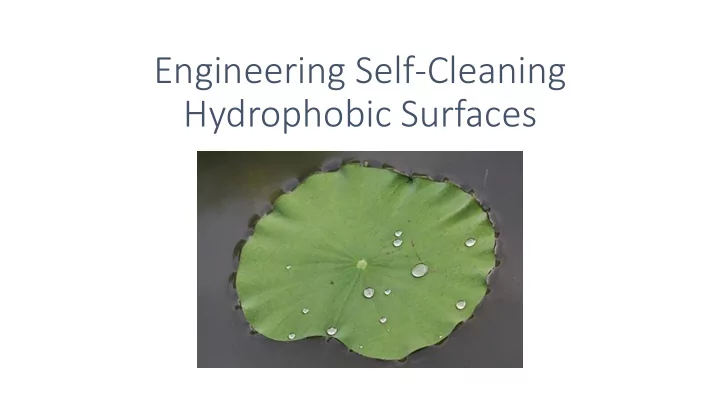

Engineering Self-Cleaning Hydrophobic Surfaces
Nanoscale Nanoscale: nanomaterials that typically measure between 1 nm and 1000 nm Nanomaterials typically measure between 1nm and 1000 nm
Nanoscale At this size, materials begin to exhibit unique properties that affect physical, chemical, and biological behavior At this size, materials begin to exhibit unique properties that affect physical, chemical, and biological behavior
Biomimicry Have you ever noticed how water rolls off a leaf, or how a lily pad floats on water? These plants parts are said to be “ superhydrophobic ” and their leaves never get dirty. Why is this?
What is the hydrophobic effect? • Hydrophobic comes from the word hydro (water) and phobos (fear). It can be demonstrated by trying to mix oil and water.
Superhydrophobic Surfaces High Contact Angle and Low Roll Off Angle Aids in Cleaning Diagram of water on tilted surface
Using self-cleaning products, you may be able to avoid stained clothing and dirty cars.
Ultra Ever Dry (Video)
Your Challenge You are a part of a team of materials engineers at a company that specializes in waterproofing materials. Your team has been asked to create a product that can make any surface dirt and stain resistant.
Make Observations – Define your Problem Choose Materials Surfaces to Water Proofing Tools to Modify Modify Materials • sandpaper • 10 cm x 10 cm • wax • wax paper wood • crayons • sand • 10 cm x 10 cm • flax seed oil cotton fabric • lanolin • clay • glue
Plan & Design • Must have a written plan for chosen surface. • What material will you modify. • What industry is this for? • How will you modify? • What tools and materials will you use to modify your surface? • Explain how and why you are using each material. • Sketch your design.
Create/Modify • Modify your surfaces. • Make sure to adjust and make note of any changes to your original plan as you create.
Investigate and Test Step 1: Observe surface and record. Step 2: Drop profile / Contact angle Step 3: Tilt / Roll off angle
Testing Self Cleaning Ability 1. You will be provided with “dirt” to make your surfaces dirty. 2. Sprinkle the “dirt” on your surface. 3. Measure the initial mass. Record in data table below. 4. Over a sink pour water over your material until all water is gone. 5. Measure final mass of material after cleaning. Record in data table below. 6. Repeat steps 2-5 for material 2.
Reflections/Improvements • Discuss and answer reflections questions the with group. • Remember properties of a superhydrophobic surface! • Water contact angle above 150º • Water roll off below 10º • Create a poster with following information: • Your groups specific problem, chosen material, proposed solutions, results (surface observations, tilt angle, and drop profile), and conclusion that includes future work. • Choose a spokesperson to communicate results.
Recommend
More recommend